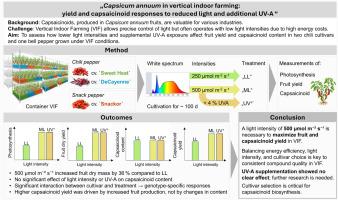垂直室内种植的辣椒:产量和辣椒素对减少光照和增加UV-A的响应
IF 4.2
2区 农林科学
Q1 HORTICULTURE
引用次数: 0
摘要
辣椒素是一种在辣椒果实中生物合成的具有多种工业应用价值的化合物。它们的持续生产是必不可少的,但受光强和光谱等环境因素的影响。垂直室内农业(VIF)系统提供对生长条件的精确环境控制,特别是光,但高能源成本往往需要降低光强度。虽然辣椒是需要光的植物,但将它们整合到VIF系统中需要在能量输入和作物性能之间取得平衡。为了评估在节能条件下种植辣椒的可行性,我们研究了两种降低光照强度(250 / 500µmol m⁻²s⁻¹)对两种辣椒品种和一种甜椒在VIF条件下果实产量和品质的影响。此外,我们评估了500µmol m - 2 s的UV-A照射是否可以促进辣椒素的积累。光强和UV-A对单位干果质量辣椒素含量影响不显著。然而,品种和处理之间的显著相互作用表明基因型特异性反应。中等光照强度(500µmol m⁻²s⁻¹)显著增加了净光合作用和果实数量,导致干果产量(12.5-29.2 gDW植物毒血症)比低光照强度(250µmol m⁻²s⁻¹)高33 - 57%,并导致不同品种的辣椒素产量相应增加。500µmol m的光照水平对于最大限度地提高VIF的产量和辣椒素产量是必要的,而品种选择在决定化合物积累方面起着关键作用。本文章由计算机程序翻译,如有差异,请以英文原文为准。

Capsicum annuum in vertical indoor farming: yield and capsaicinoid responses to reduced light and additional UV-A
Capsaicinoids, biosynthesized in pepper fruits (Capsicum annuum), are valuable compounds with diverse industrial applications. Their consistent production is essential but influenced by environmental factors such as light intensity and spectrum. Vertical indoor farming (VIF) systems offer precise environmental control over growing conditions, especially light, yet high energy costs often necessitate reduced light intensities. While peppers are light-demanding plants, their integration into VIF systems requires a balance between energy input and crop performance. To evaluate the feasibility of cultivating Capsicum annuum under energy-saving conditions, we investigated the effects of two reduced light intensities (250 / 500 µmol m⁻² s⁻¹) on fruit yield and quality across two chili pepper cultivars and one bell pepper in VIF conditions. Additionally, we assessed whether supplemental UV-A exposure at 500 µmol m⁻² s⁻¹ could enhance capsaicinoid accumulation.
Capsaicinoid content per unit dry fruit mass was not significantly affected by light intensity or UV-A as main effects. However, a significant interaction between cultivar and treatment indicated genotype-specific responses. Medium light intensity (500 µmol m⁻² s⁻¹) significantly increased net photosynthesis and fruit number, resulting in 33–57 % higher dry fruit yield (12.5–29.2 gDW plant⁻¹) compared to the lower intensity (250 µmol m⁻² s⁻¹), and led to a corresponding increase in capsaicinoid yield per area, depending on cultivar. Light levels of 500 µmol m⁻² s⁻¹ are necessary to maximize yield and capsaicinoid output in VIF, while cultivar selection plays a critical role in determining compound accumulation.
求助全文
通过发布文献求助,成功后即可免费获取论文全文。
去求助
来源期刊

Scientia Horticulturae
农林科学-园艺
CiteScore
8.60
自引率
4.70%
发文量
796
审稿时长
47 days
期刊介绍:
Scientia Horticulturae is an international journal publishing research related to horticultural crops. Articles in the journal deal with open or protected production of vegetables, fruits, edible fungi and ornamentals under temperate, subtropical and tropical conditions. Papers in related areas (biochemistry, micropropagation, soil science, plant breeding, plant physiology, phytopathology, etc.) are considered, if they contain information of direct significance to horticulture. Papers on the technical aspects of horticulture (engineering, crop processing, storage, transport etc.) are accepted for publication only if they relate directly to the living product. In the case of plantation crops, those yielding a product that may be used fresh (e.g. tropical vegetables, citrus, bananas, and other fruits) will be considered, while those papers describing the processing of the product (e.g. rubber, tobacco, and quinine) will not. The scope of the journal includes all horticultural crops but does not include speciality crops such as, medicinal crops or forestry crops, such as bamboo. Basic molecular studies without any direct application in horticulture will not be considered for this journal.
 求助内容:
求助内容: 应助结果提醒方式:
应助结果提醒方式:


